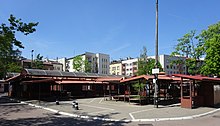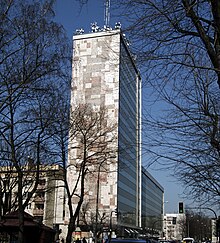Nowa Wieś (Krakow)
Nowa Wieś (German Neudorf ) is a district of Kraków in Poland , in the district of V Krowodrza , northwest of Kraków's old town .
history
In 1257, the governor city of Krakow, which was re-established this year after the destruction by the Mongols, received the fields in the area of the later villages of Czarna Wieś , Łobzów and Nowa Wieś. They were confiscated by the Polish king after the Kraków uprising of Bailiff Albert (1311/1312). The new village per locacionem Nove Ville , Nowa Wieś in Polish, was founded in 1367 by King Casimir the Great under German law. The Latin name Nova Villa was used in the Middle Ages, e.g. B. by Jan Długosz (1470-1480), later the Polish name Nowa Wieś with the adjective Łobzowska (1564) or Królewska (royal) was added, while Łobzów was sometimes referred to as Antiqua Villa or Stara Wieś (Altdorf).
The village initially belonged to the Kingdom of Poland (from 1569 in the aristocratic republic of Poland-Lithuania ), Krakow Voivodeship , Proszowice District (later Kraków District).
In the third partition of Poland , Nowa Wieś became part of the Habsburg Empire in 1795 . In the years 1815-1846 the village belonged to the Republic of Cracow and was renamed Nowa Wieś Narodowa ( national new village ).
In 1846 it was annexed again to the countries of the Austrian Empire as part of the Grand Duchy of Krakow . From 1855 Nowa Wieś was part of the Kraków District . Urbanization began at the beginning of the 20th century. Occasionally at that time the village was also named Neudorf in German .
In 1900 the community Nowa Wieś Narodowa had an area of 92 hectares with 146 houses and 2373 inhabitants, the majority of whom were Roman Catholic (2271) and Polish-speaking (2220), there were 92 Jews, 11 residents were German-speaking.
On April 1, 1910, the community was incorporated into Krakow. In 1921 the district XV. Nowa Wieś 254 buildings with 4107 inhabitants, the majority of whom were Polish (4047) and Roman Catholic (3920), and 162 Jews were part of the largest religious minority (44 according to nationality, the remaining 118 saw themselves mostly as Polish, but Jewish religion).
In the interwar period , new villas were built for the professors of Kraków's universities, and some large buildings were also built. During the Second World War, the German occupiers under the direction of Theodor Bauder erected a few dozen multi-storey buildings based on the light and air principle . The model estate, the largest investment of its kind in the entire Generalgouvernement , was made accessible by a new tram line "only for Germans".
Individual evidence
- ↑ a b Królewska wieś na skraju miasta ( pl ) dziennikpolski24.pl. January 31, 2009.
- ↑ a b Kazimierz Rymut : Nazwy miejscowe północnej części dawnego województwa krakowskiego . Polska Akademia Nauk . Instytut Języka Polskiego, Wrocław 1967, p. 114 (Polish, online ).
- ↑ Ludwig Patryn (Ed.): Community encyclopedia of the kingdoms and countries represented in the Reichsrat, edited on the basis of the results of the census of December 31, 1900, XII. Galicia . Vienna 1907 ( online ).
- ↑ Główny Urząd Statystyczny: Skorowidz miejscowości Rzeczypospolitej Polskiej. Województwo krakowskie i Śląsk Cieszyński . Warszawa 1925, p. 17 [PDF: 27] (Polish, Woj.krakowskie i Sląsk Cieszynski miejscowości.pdf ).
- ↑ Kamila Twardowska: Osiedle niemieckie przy ul. Królewskiej ( pl )
Coordinates: 50 ° 4 ′ N , 19 ° 55 ′ E


